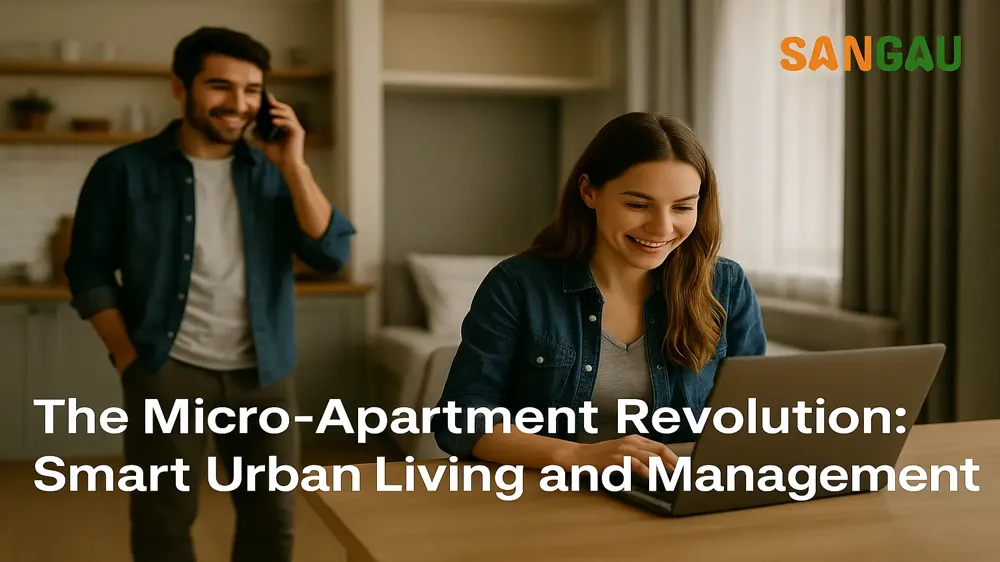The Micro-Apartment Revolution - Smart Urban Living and Management
Published : 25 Jun 2025

The Micro-Apartment Revolution: Smart Urban Living and Management
Introduction
Hello property investors and urban dwellers! Today, we’re exploring the growing trend of micro-apartments—an innovative solution to rising urban density, increasing housing costs, and evolving lifestyle needs. These compact, multifunctional spaces are redefining city living, offering affordability, sustainability, and a strong sense of community. Let's dive into the world of micro-apartments and understand why they are shaping the future of urban real estate.
Understanding Micro-Apartments: The Rise of Compact Living
Micro-apartments are small, highly efficient residential units, typically ranging from 150 to 400 square feet. Despite their size, they are cleverly designed to optimise space and functionality, making them an attractive housing option in crowded metropolitan areas. This trend is being driven by skyrocketing urban housing costs and the need for more affordable living solutions. Cities like New York, Tokyo, and London have embraced micro-apartments as a practical response to space constraints, allowing residents to enjoy central locations without the hefty price tag. For property investors and landlords, micro-apartments represent a profitable opportunity, enabling more rental units per building while addressing modern urban housing demands.
Affordability and Financial Benefits: A Smart Investment
The affordability of micro-apartments is one of their biggest selling points. With rental rates typically 20-30% lower than traditional units, tenants can live in prime city locations without overextending their budgets. For young professionals, students, and digital nomads, micro-apartments provide a cost-effective solution to urban living without sacrificing access to work, transport, and social amenities. For property owners, micro-apartments offer excellent rental yield potential. Higher occupancy rates, coupled with efficient property management, make them a lucrative investment. By maximising rental revenue per square foot, landlords can generate substantial returns while maintaining competitive pricing for tenants.
Space Optimisation: Living Large in Small Spaces
One of the key innovations behind micro-apartments is intelligent design. Smart layouts ensure that every square inch is utilised effectively, creating a functional and comfortable living environment. High ceilings and large windows create an illusion of space, while neutral colour schemes and sleek finishes prevent a cramped feel. Multifunctional furniture plays a crucial role in making micro-apartments adaptable. Foldable tables, Murphy beds, and hidden storage compartments transform spaces effortlessly, enabling residents to switch between work, relaxation, and social activities with ease. These design strategies make compact living practical and appealing.
Sustainable Living: Reducing Environmental Impact
Sustainability is a key advantage of micro-apartments. With smaller living areas, residents naturally consume less energy and water, leading to lower utility bills and a reduced carbon footprint. Many developments integrate eco-friendly features such as energy-efficient appliances, solar panels, and rainwater harvesting systems, aligning with global sustainability goals. For eco-conscious tenants, micro-apartments offer a way to embrace a minimalist lifestyle while actively contributing to environmental conservation. Property owners benefit too, as green-certified buildings attract tax incentives and appeal to the growing market of sustainability-focused renters.
Community Living: Enhancing Social Connections
Micro-apartment complexes often include shared amenities that foster a strong sense of community. Co-working spaces, communal kitchens, lounges, and fitness centres provide residents with additional social and functional areas beyond their individual units. These shared spaces create a balance between private living and social engagement, enhancing tenant satisfaction and retention. Property managers who invest in well-maintained communal areas can significantly improve the desirability of their micro-apartment buildings, making them attractive long-term living options.
Overcoming Long-Term Living Challenges
While micro-apartments offer affordability and convenience, long-term occupancy can present challenges such as limited personal space and reduced privacy. For tenants working remotely, the need for separate work and living areas is increasingly important. To address these concerns, property managers can introduce flexible lease terms, upgrade shared facilities regularly, and allow residents to personalise their units with temporary design elements. Creating a vibrant, adaptable environment ensures that tenants remain comfortable and engaged, even in compact spaces.
Regulatory Considerations for Micro-Apartment Developments
Managing micro-apartments requires adherence to local housing regulations and zoning laws, which vary across cities. Some regions impose minimum size requirements and specific building codes that affect the feasibility of micro-apartment developments. Property owners and investors must stay informed about regulatory changes and ensure compliance to avoid legal complications. Partnering with experienced property management services can help navigate these requirements efficiently, ensuring smooth operations and long-term success.
Smart Technology: Enhancing the Micro-Apartment Experience
The integration of smart home technology is revolutionising micro-apartment living. Tenants can control lighting, temperature, and security systems via mobile apps, enhancing convenience and efficiency within their compact homes. For property managers, automation simplifies maintenance and communication. Remote monitoring, predictive maintenance, and digital lease management streamline operations, reducing costs and improving tenant experiences. Investing in smart technology is a strategic move that boosts property value and attracts tech-savvy renters.
Adapting to Remote Work: Creating Multi-Functional Spaces
The rise of remote work has shifted housing priorities, with tenants seeking functional work-from-home solutions. Micro-apartment developers are responding by incorporating built-in desks, ergonomic seating, and soundproof communal workspaces within their buildings. Offering co-working areas within micro-apartment complexes enhances the appeal for freelancers, entrepreneurs, and digital nomads. By adapting to evolving work trends, property managers can position their buildings as ideal urban hubs for productivity and convenience.
Future Prospects: The Global Expansion of Micro-Apartments
As urban populations grow and housing costs continue to rise, micro-apartments will become an integral part of the global housing market. Innovations in modular construction, space-saving technology, and sustainable building materials will further enhance their appeal. Governments and developers worldwide are recognising the benefits of compact, affordable living solutions, ensuring that micro-apartments remain a viable option for future city dwellers. The trend towards smaller, smarter, and greener living spaces is only set to expand.
How SANGAU Can Support Your Micro-Apartment Investment
For landlords and property managers looking to invest in micro-apartments, SANGAU offers expert services to streamline property management, tenant retention, and smart technology integration. Our team ensures that your property remains competitive, profitable, and attractive to modern urban dwellers.
Hashtags
#MicroApartments #UrbanLiving #PropertyManagement #SustainableHousing #SANGAU


